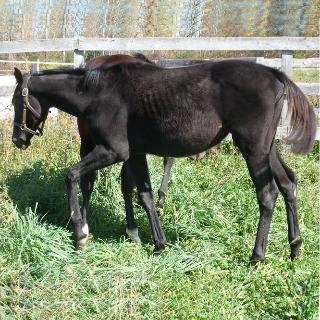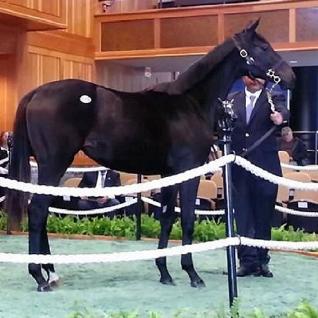| At Damrock Farm, we take sales preparation very seriously. Proper sales prep can mean the difference between being a top seller at a sale and an also-ran or even worse, a no-sale. If your horse is prepped at Damrock, you can be assured that he or she will bring every dollar that previous care, bloodlines and conformation will allow. Sales prep agents, Damrock Farm included, do everything in their power to make their client's horse look more attractive to the buyer than the horse in the next barn. The most well-bred horse in the world will not bring top dollar if he is not in optimum condition when he arrives on the sale grounds. While at Damrock, your horse will receive a diet, exercise and grooming program that will have him in peak condition and able to show of his best attributes at sale time. Your Damrock Farm prepped horse will get noticed! When your horse arrives at Damrock, usually 90 days before sale time, he will initially be stalled and just allowed to settle in for two or three days. The first few days, to help prevent possible colics, he will receive only as much good hay as he can eat. Once he is comfortable in his new surroundings, concentrates will gradually be added and the amount of hay will be decreased to reach a good balance allowing for both growth, weight gain and safety in his diet. Sale horses are turned out at night so that they don't get sunburned, yet still have time to play and be a horse. They are placed in individual paddocks, but with neighbors. This allows them the companionship that, as herd animals, they desperately need while still keeping them safe from injuries caused by too much roughhousing. The last few weeks before the sale, the horses are kept inside to accustom them to the routine at the sales barn. Every horse that comes to Damrock for prep will first spend a few days working in the round pen to develop respect for the handlers. Our round pen is 80 feet rather than the traditional 60 feet to minimize the possiblilty of joint damage, especially in young horses. I have found that this initial round pen training makes future work with the horse safer and more enjoyable for all concerned, including the horse. Proper round penning teaches a horse to look to the handler as a leader and helps the horse to understand that the handler can and will gain control without hurting or intimidating him. This eliminates many battles that at some other facilities take place on the end of a lead shank, where the possibility of injury to handler or horse is much greater. While in the round pen, I start working with the horse's feet and body, getting them accustomed to lifting their feet and allowing their legs and body to be handled. At the sales, many buyers will want to feel the horse's legs, looking for any indication of swelling or heat that might not be noticeable just by looking. They may want x-rays or even a scope done. All of these require that your horse be well-mannered and accepting of this type of activity. Feet need to be trimmed, some horses might need shoes. If the horse is not trained to accept such handling, many buyers will simply move on to the next horse and cross yours off their list. Once the horse is responding to the work done in the round pen, he will start learning how to properly walk beside the handler on the lead. Proper positioning with the handler midway between the head and shoulder allows buyers to easily see all four feet when the horse is shown. Your horse will learn to walk at a brisk 4 mph without dragging behind or forging ahead of the handler. He will learn proper inside and outside turns and that whoa means whoa. He will be taught the 4-point stance which both allows all four legs to be seen from both sides of the horse and when properly done, shows a relaxed and balanced horse. The correct 4-point stance places the near legs squarely under the horse with the cannon bones perpendicular to the ground. The off legs are placed slightly in, enough to show the feet, pasterns, knees and hocks while still remaining straight and balanced. If you look at the pictures below, you will see two examples of the 4-point stance, one good, one bad. You can see what a difference proper stance makes in creating a good overall picture of the horse. Along with learning good manners and proper technique, every sale horse undergoes a vigorous grooming regimen. Each day, the horses are curried, brushed and rubbed to create a beautiful, shiny, healthy looking coat. Manes are shortened a little at a time by hand pulling until they are about 4-5 inches long. I don't believe in cutting the mane to shorten it unless the mane is very thin. With an extremely thin mane, pulling can make it look scraggly and sparse. In most cases though, the manes look much better when they are pulled so that they achieve a natural look, but at the desired length. Sale horses are acclimated to clippers so that at sale time we can make them look their best by clipping fetlocks, ears, muzzles and bridle paths. Work with the feet continues every day so that any farrier work required can be taken care of, usually about every 4-5 weeks. The last trim or shoeing will take place within a few days of the sale. Last, one of the most important factors in preparing sale horses is a dedicated exercise routine. While proper weight is fairly easy to achieve, proper conditioning takes work and lots of it. At the sales, horses will go in and out of their stalls, often as many as 50-100 times a day. They will have to walk up and down in front of the buyers, sometimes several times if a buyer is very interested. A horse who is not in condition will quickly tire and not show well to prospective buyers. Buyers do not want to see a horse who is dragging behind the handler, nor one who is grumpy and uncooperative because he is tired. They look for a horse who walks out of his stall willingly, moves along briskly, and seems happy and interested in his surroundings. If the horse is dragging behind, or won't walk along at a brisk pace, it makes it much more difficult for a buyer to make a judgement as to the horse's movement. If the buyer can't see a horse move well enough to make that judgement, he will bid on one he can. At Damrock, each sale horse is walked and trotted every day to slowly build stamina and condition. By sale time, they will be up to at least an hour of straight walking every day and will walk willingly beside the handler. A properly conditioned horse will be able to take the rigors of the sale atmosphere without losing too much weight or becoming too tired. A horse who is not only in good weight, but also properly conditioned, will be much more appealing to buyers. The return on this investment in time and energy will definitely be seen in the sale ring! |
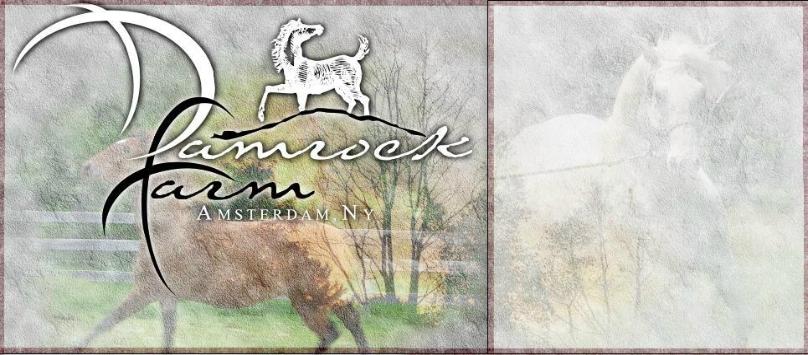
Sales
Preparation
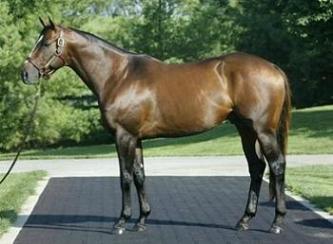
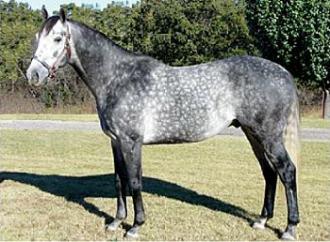
| A good example of the 4-point stance. |
A poor example of the 4-point stance.
| Pam and Dave Zielinski, owners 877 State Highway 67 Amsterdam, NY 518-843-9311 |
| Filly bought as a weanling as a resale project. |
